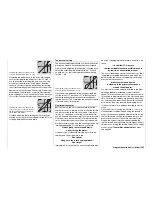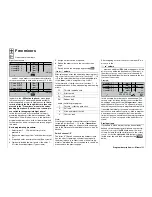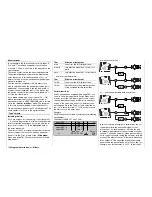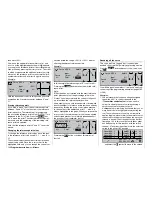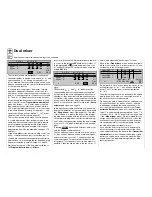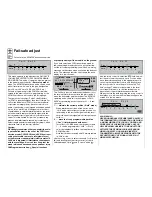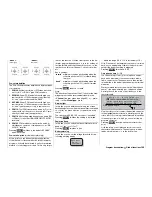
145
Program description:
Mixers
Tip:
You can check all the settings directly by calling up
the »
Servo display
« menu.
Further typical applications:
•
Model with two rudders, with differential travel and
outward movement as airbrakes (e. g. swept-back
fl ying wing):
Dual mixer 1: “
8
” and “
RU
”, Diff. = -75%.
When a rudder command is given, the second
servo, connected to receiver output 8, follows the
movement of the fi rst rudder servo (with this me-
thod of programming it is possible to set differenti-
al travel for the two rudders). In this case the rud-
der stick trim lever affects both servos. If the rud-
ders are also required to defl ect outwards when
the airbrakes are extended, then you should as-
sign the C1 stick (transmitter control 1) to Input 8
in the »
Transmitter control adjust
« menu. Now
move to the “Offset” column, and adjust the Offset
value until both rudders return to the neutral posi-
tion. You may have to “play” a little with the offset
and travel settings to obtain the results you desire.
•
V-tail with differential rudder travel:
In the »
Model type
« menu you
MUST
enter the
tail type as “normal” for this application.
Dual mixer 1: “
EL
” and “
RU
”, Diff. (typical-
ly) = -75%
Both servos operate either as elevators or rudders
according to the way the transmitter controls are
moved. The differential travel is only effective when
a rudder command is given, in accordance with
the channel assignment of the dual mixer. In this
case both trim levers are effective. No additional
free mixers are required for this arrangement.
SEL
S W A S H M I X E R
P i t c h
+ 61%
R o l l
P i t c h a x .
+ 61%
+ 61%
In the »
Helicopter type
« menu you have already de-
fi ned the number of servos which are installed in your
helicopter for collective pitch control; see page 72.
With this information the
mx
-24s program automati-
cally couples together the functions for roll, pitch-axis
and collective pitch as required, so that you do not
need to defi ne any additional mixers yourself.
If you have a model helicopter which only has
a sing-
le collective pitch servo
, this menu point is – of course
– superfl uous, since the three swashplate servos for
collective pitch, pitch-axis and roll are controlled inde-
pendently of each other. In this case the swashplate
mixer menu does not appear in the multi-function list.
With all other swashplate linkages employing 2 … 4
collective pitch servos, the mixer ratios and directions
are set up by default, as can be seen in the screen-
shot above. The pre-set value is 61% in each case,
but the value can be varied within the range -100%
to +100% if required, after a brief press on the rota-
ry control.
(Pressing
CLEAR
= 61%.)
If the swashplate control system (collective pitch,
roll and pitch-axis) does not respond to the transmit-
ter sticks in the way you expected, then the fi rst step
should always be to change the mixer directions (+
or -), before you attempt to correct the directions of
servo rotation.
HEIM mechanics with two collective pitch servos:
• the
collective pitch mixer
acts on the two collective
pitch servos connected to receiver sockets 1 + 2;
• the
roll mixer
also acts on the two collective pitch
Swashplate mixer
Collective pitch, roll and pitch-axis mixers
servos, but the direction of rotation of one servo is
reversed, and
• the
pitch-axis mixer
acts on the pitch-axis servo
alone.
Note:
Check carefully that the servos do not strike their me-
chanical end-stops if you change the servo mixer va-
lues.
Содержание mx-24s
Страница 1: ...1...
Страница 19: ...19 For your notes...
Страница 35: ...35 For your notes...
Страница 41: ...41 41 For your notes...
Страница 57: ...57 For your notes...
Страница 63: ...63 63 For your notes...
Страница 69: ...69 69 For your notes...
Страница 85: ...85 85 For your notes...
Страница 99: ...99 For your notes...
Страница 143: ...143 For your notes...
Страница 191: ...191 For your notes...
Страница 212: ...212 212 For your notes...
Страница 213: ...213 213 For your notes...
Страница 214: ...214 For your notes...
Страница 216: ...216...

